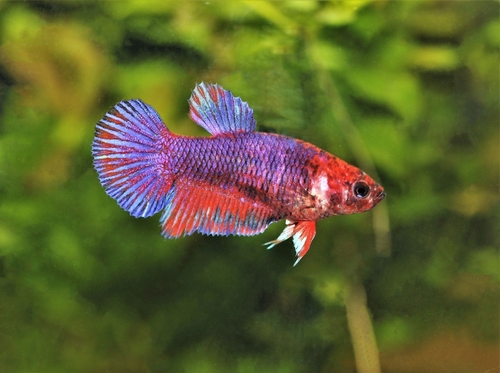Betta fish are very territorial, making it dangerous to house them with other bettas. Having a community tank is much more interesting to look at, but you’ll need to know what tank mates to choose. If you add the wrong fish, the betta will fight them!
If you’re searching for “15 best betta tank mates 5 gallons” online, you should choose ones that are similar in size to your betta and have short tails. Bettas also avoid fish that swim along the bottom or in groups.
You’ll find the perfect tank mate to get along peacefully with your feisty betta below.
Contents
Betta Tank Mates — What To Know

Betta fish are very aggressive, so they’ll pick on most other fish. However, if you choose a good tank mate, the betta fish should leave them alone. In general, you want to choose friendly fish the same size as the betta.
However, picking a good companion for a betta is a bit more complicated than that. You also need to ensure that the fish likes the same tank size and conditions.
Temperament
Bettas can be very protective of their territory, so the best tank mates are relaxed and peaceful fish. You must avoid aggressive species as they constantly fight with the betta, which can lead to injury.
Fish that prefer to travel in groups, known as schools, are also an excellent option for tank mates. When you can fit a large school in your tank, the betta won’t bother any fish from that group.
Size
If they’re too small, the betta could pick on them. Most bettas are between two and three inches long, although the males with large fins can be a few inches longer than that.
It’s also essential that your betta tank buddies don’t have fancy tails and fins. Extravagant fins can attract the attention of the betta, causing it to harass that fish constantly.
Competition
Bettas are territorial, so they don’t like when a particular fish is always in their space. You should choose those that like swimming along the bottom since bettas don’t usually go down that far.
Additionally, bettas compete less with nocturnal species since they’re much more active during the day.
Parameters ; Tank Setup
Lastly, you must ensure that your betta and its new friends live in the same tank conditions. Bettas need a pH between 6.8 and 7.5. They also need to be in water temperatures between 76° and 85°F.
As for the tank setup, one to two natural plants and gravel are best. You can use fake plants and other decorations, but you must check that they won’t tear the betta’s tail.
Betta Tank Mates 5 Gallon
Now that you know what makes for good betta tank mates, let’s cover all the best ones!
You also don’t want to miss out these other popular posts:
1. Mystery Snails
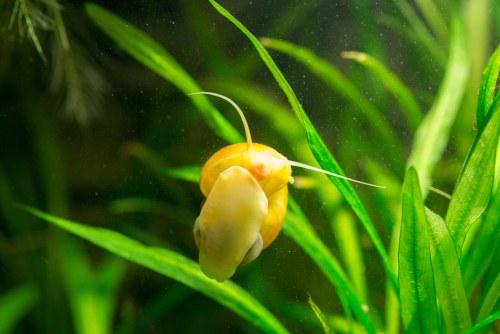
- Scientific Name: Pomacea bridgesii
- Adult Size: 1-2 inches
- Compatible with: Male and female bettas
- Water Temperature: 68-82°F
- Minimum tank size: Five-gallons
- Care Level: Easy
- Origin: Asia
Mystery snails are great tank mates for bettas due to their chill personalities. They also help keep the tank clean by eating algae and fish waste. Mystery snails will help you learn how to take care of your tank if you’re a beginner at fishkeeping.
Overall, mystery snails are the perfect companion for betta fish. They’ll co-exist peacefully alongside the betta and keep your tank clean. We recommend having only one of these snails in your five-gallon tank to ensure they get enough to eat.
Pros of Mystery Snails With Bettas
- Mystery snails are peaceful and slow-moving, so bettas leave them alone.
- Mystery snails make the perfect clean-up crew for your tank by eating algae and waste.
- Adult mystery snails are too large to be eaten by a betta.
Cons of Mystery Snails With Bettas
- You can only keep one snail in a tank this size.
2. Zebra Snails

- Scientific Name: Neritina natalensis
- Adult Size: 1 inch
- Compatible with: Male and female bettas
- Water Temperature: 65°-85°F
- Minimum tank size: Two-gallons
- Care Level: Easy
- Origin: South Africa
Next, zebra snails are also great tank buddies for a betta. Like the mystery snail, they clean up debris in the tank and are super easy to raise. The bettas won’t bother these non-aggressive snails at all.
However, they’re a bit smaller than mystery snails, so you need to be careful the betta doesn’t eat any young ones. The adults should still be too large for them.
Finally, if you’re growing natural plants in the tank, your zebra snails won’t eat them.
Pros of Zebra Snails With Bettas
- Zebra snails keep the environment clean for your betta.
- Zebra snails are non-aggressive and won’t attract the betta’s attention.
- Adult zebra snails are too large to be eaten by a betta.
Cons of Zebra Snails With Bettas
- Zebra snails can escape a tank easily.
- Zebra snails reproduce quickly.
3. Red Cherry Shrimp
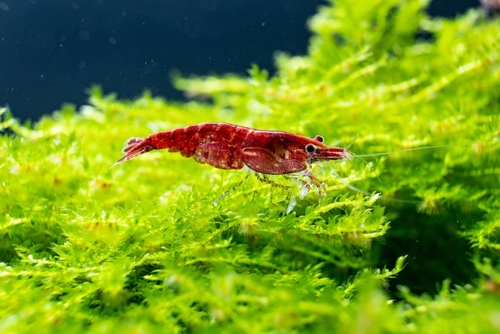
- Scientific Name: Neocaridina heteropoda
- Adult Size: 1.5 inches
- Compatible with: Male and female bettas
- Water Temperature: 65-80°F
- Minimum tank size: Two-gallons
- Care Level: Easy
- Origin: Taiwan
Red cherry shrimp are animated creatures, making them exciting to watch. They’re small and peaceful, making them compatible with betta fish. On top of that, your shrimp will pick at algae and food waste, keeping the water clear for your betta.
You can easily keep one or two red cherry shrimp in a small betta tank, but you’ll want to provide a few plants to hide in.
Pros of Red Cherry Shrimp With Bettas
- Cherry shrimp clean up after your betta.
- Cherry shrimp usually stay at the bottom of the tank.
- Cherry shrimp are colorful and look great when paired with bright bettas.
Cons of Red Cherry Shrimp With Bettas
- Bettas will try to eat any babies your shrimp have.
4. Ghost Shrimp
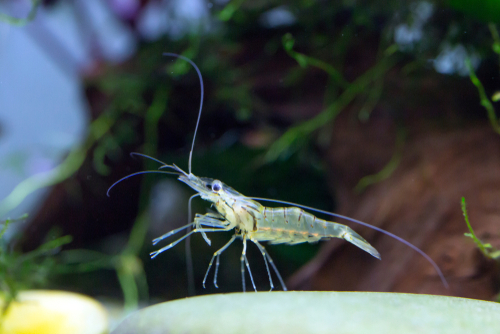
- Scientific Name: Palaemonetes paludosus
- Adult Size: 1-2 inches
- Compatible with: Male and female bettas
- Temperature: 70-82°F
- Minimum tank size: Two-gallon
- Care Level: Easy
- Origin: North America
Ghost shrimp are another fun betta companion. They’re clear, so they don’t distract from the vibrant colors of your betta. Plus, they hang out on the floor of the tank, which is outside of the betta’s territory.
These shrimp can be tiny before they reach adulthood, so you’ll need to keep them out of your betta’s tank until they’re at least one inch big. Then, add up to two to your five-gallon tank.
Overall, these shrimp are another bottom feeder that will assist in keeping your betta’s space sanitary.
Pros of Ghost Shrimp With Bettas
- Ghost shrimp clean up algae and waste in the substrate.
- Ghost shrimp and bettas keep their distance from each other.
Cons of Ghost Shrimp With Bettas
- Bettas will eat young ghost shrimp.
5. Amano Shrimp
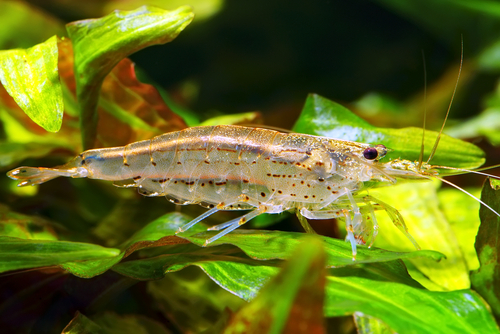
- Scientific Name: Caridina multidentata
- Adult Size: 2 inches
- Compatible with: Male and female bettas
- Water Temperature: 64-80°F
- Minimum tank size: Two-gallons
- Care Level: Medium
- Origin: Japan
Amano shrimp are best for betta tanks with many natural plants. They’ll stay hidden in the plants as much as possible and clean the algae from them. These shrimp always clean along the bottom of the tank, out of the betta’s way.
Once they become adults, they’ll be too large for a betta to eat, so they’ll get ignored by them.
Pros of Keeping Amano Shrimp With Bettas
- Amano shrimp are great at keeping planted freshwater tanks clean.
- Amano shrimp stay along the bottom, away from the betta.
Cons of Keeping Amano Shrimp With Bettas
- Some Amano shrimp can be too small, and the betta might snack on them.
6. Cory Cats
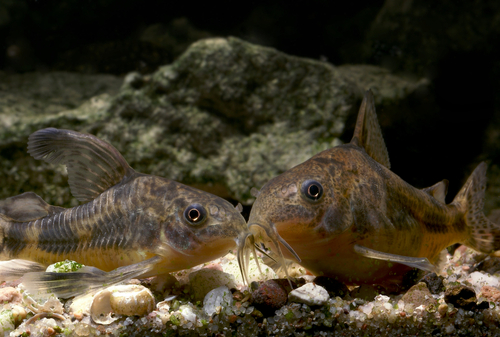
- Scientific Name: Corydoras paleatus
- Adult Size: 1-3.5 inches
- Compatible with: Male and female bettas
- Water: 72-82°F
- Minimum tank size: Five-gallons
- Care Level: Easy
- Origin: South America
Cory cats are well-mannered catfish, making them good tank mates for bettas. Some species thrive in smaller tanks and scavenge through debris along the bottom of the tank. Most cory cats will be large enough that the betta can’t intimidate them.
In short, the cory cats won’t act aggressively with the betta and should steer clear of it.
Pros of Keeping Cory Cats With Bettas
- Cory cats have a calm temperament and won’t instigate the betta.
- Cory cats are a species of catfish, so they stay on the bottom out of the betta’s reach.
- Cory cats are efficient cleaners.
Cons of Keeping Cory Cats With Bettas
- Betta tanks can be too small for some cory cat species.
7. Otocinclus Catfish
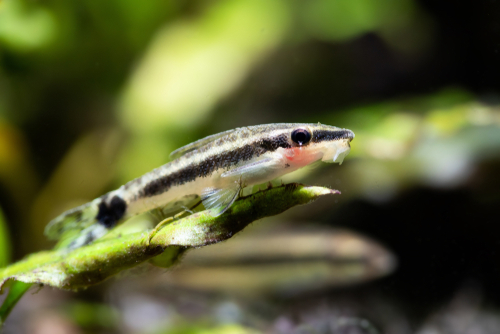
- Scientific Name: Otocinclus vestitus
- Adult Size: 1.5-2 inches
- Compatible with: Some males, female bettas
- Water Temperature: 72-82°F
- Minimum tank size: 5 to 10 gallons
- Care Level: Easy
- Origin: South America
These catfish are perfect tank mates for many of the same reasons as cory cats. They’re calm, remain on the bottom of the tank, and keep the substrate clean. However, they also travel in groups, making it harder for bettas to bother them.
Pros of Keeping Otocinclus Catfish With Bettas
- Otocinclus catfish are very social and peaceful.
- They prefer to live in schools.
- They spend their time on the bottom of the tank, away from bettas.
- Otocinclus catfish eat debris in the substrate, keeping it clean.
Cons of Keeping Otocinclus Catfish With Bettas
- These catfish need plenty of plants to hide in.
- Ottos must be in groups, making it hard to fit large schools in small tanks.
8. Harlequin Rasbora
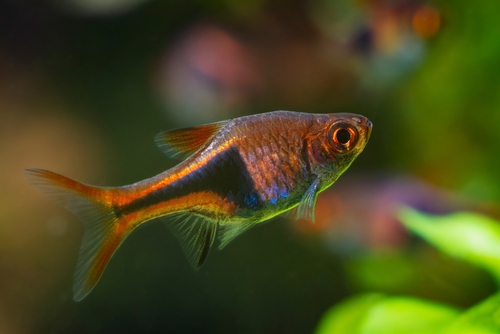
- Scientific Name: Trigonostigma heteromorpha
- Adult Size: 2 inches
- Compatible with: Some males, female bettas
- Water Temperature: 72-81°F
- Minimum tank size: 5 to 10 gallons
- Care Level: Easy
- Origin: Asia
Harlequin rasbora prefer to travel in schools, so bettas tend to leave them alone. Even if the betta were to attack a rasbora, the rasbora is much faster and would easily escape. Large schools need larger tanks, but you can fit two or three rasboras in a five-gallon.
Pros of Keeping Harlequin Rasbora With Bettas
- Bettas leave the rasboras alone since they swim in groups.
- Rasboras are much faster than bettas and can outswim them if they become aggressive.
Cons of Keeping Harlequin Rasbora With Bettas
- Larger rasbora schools need more room than five gallons.
- Rasboras swim in the areas where the bettas are, which can make them territorial.
9. Brigittae Rasbora
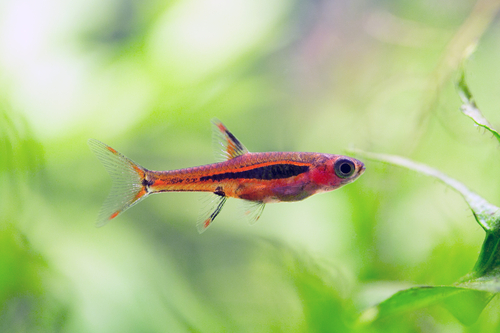
- Scientific Name: Boraras brigittae
- Adult Size: 0.7 inches
- Compatible with: Some males, female bettas
- Water Temperature: 68-82.4°F
- Minimum tank size: Five-gallons
- Care Level: Easy
- Origin: Asia
Brigittae rasboras are exceptionally timid and tiny fish, so they’ll actively avoid bettas. They like having places to hide, such as plants, and sometimes visit the tank’s bottom.
These fish also form groups, which keeps the betta away. Since they’re so small, you can fit around six in a five-gallon tank.
Pros of Keeping Brigittae Rasbora With Bettas
- These rasboras travel in schools, which discourages the bettas.
- They have very similar tank conditions to bettas.
- They’re tiny and agile, so they can outswim a betta easily.
Cons of Keeping Brigittae Rasbora With Bettas
- They’re small enough that a large betta can eat them.
- They swim on the same level as bettas.
10. Leopard/Kuhli Loach
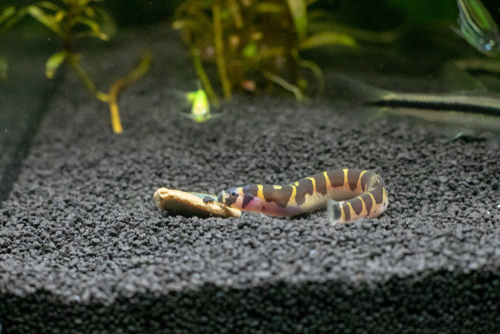
- Scientific Name: Pangio kuhlii
- Adult Size: 2.75-4 inches
- Compatible with: Female bettas
- Temperature: 76-86°F
- Minimum tank size: 10 gallons
- Care Level: Easy
- Origin: Indonesia
These loaches are shy bottom feeders, so they won’t come into contact with the betta very often. They’re also nocturnal, meaning they aren’t active when the betta is. All of these traits make them great for betta tanks.
However, you’ll need to move the loach if it gets too large for your small tank.
Pros of Keeping Loach With Bettas
- Kuhli loaches have a timid personality and avoid bettas.
- They’re active during the night when the betta sleeps.
- These loaches remain on the bottom of the tank.
Cons of Keeping Loach With Bettas
- Kuhli loaches can quickly outgrow a small five-gallon tank.
11. Mollies

- Scientific Name: Poecilia sphenops
- Adult Size: 4-4.5 inches
- Compatible with: Some males, female bettas
- Water Temperature: 75-80°F
- Minimum tank size: Five-gallons
- Care Level: Easy
- Origin: Central and South America
Mollies are another shoaling fish, meaning they travel in groups. You’ll want to have at least four of them in your tank for them to feel comfortable with the betta. Mollies are also larger than bettas, so they shouldn’t get attacked by one. Finally, mollies have a personality that’s compatible with bettas.
Pros of Keeping Mollies With Bettas
- Mollies form groups, so bettas shouldn’t attack them.
- Mollies have a timid personality.
Cons of Keeping Mollies With Bettas
- Mollies and bettas swim in the same tank levels.
- Five gallons will be too small for larger molly schools.
- Male mollies are more aggressive and are more likely to attack male bettas.
12. Platy Fish
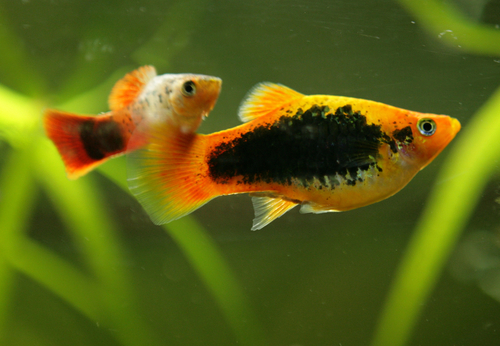
- Scientific Name: Xiphophorus maculatus
- Adult Size: 2-3 inches
- Compatible with: Male and female bettas
- Water Temperature: 70-82°F
- Minimum tank size: Five-gallons
- Care Level: Easy
- Origin: Central and Southern America
Next, platyfish can be good companions for bettas. They’re related to mollies, so they share many of the same traits. You can even find them in many fun colors that are stunning in any tank.
Platies are also schooling fish, and they have small tails, so bettas tend to ignore them.
Pros of Keeping Platy Fish With Bettas
- Platy fish sometimes travel in schools.
- They have small fins and tails, so they don’t attract the betta’s attention.
- Platies have friendly personalities and aren’t territorial.
Cons of Keeping Platy Fish With Bettas
- You can only keep a few platies in a tank this small.
- Platy fish and bettas swim in the same tank levels.
13. Least Killifish
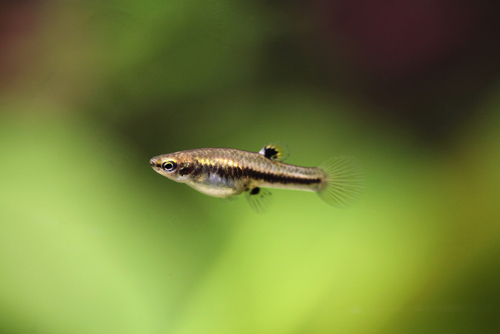
- Scientific Name: Heterandria formosa
- Adult Size: 1-2 inch
- Compatible with: Some males, female bettas
- Water Temperature: 68-75°F
- Minimum tank size: Five-gallons
- Care Level: Medium
- Origin: Africa
The least killifish is another good tank mate for a few reasons. They stay small, so they fit in five-gallon tanks. Plus, killifish prefer to live in schools, so the bettas should stay away. Killifish have a fitting personality, too, since they’re delightful and friendly fish.
Pros of Keeping Killifish With Bettas
- Killifish travel in schools, keeping bettas at bay.
- Killifish are friendly and non-aggressive.
- They’re small and can easily fit in tanks of this size.
Cons Keeping Killifish With Bettas
- Killifish and bettas swim in the same tank levels, which can cause aggression in the betta.
- Killifish schools breed quickly, and the betta will eat their spawn.
- Some male killifish can be more aggressive and may instigate bettas.
14. Celestial Pearl Danio
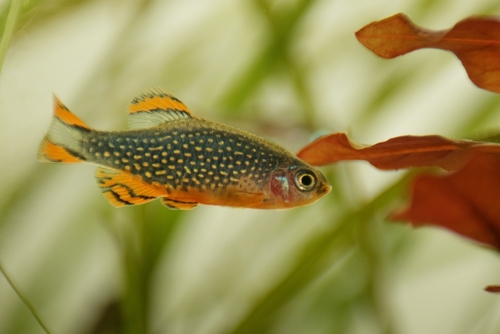
- Scientific Name: Celestichthys margaritatus
- Adult Size: 1 inch
- Compatible with: Female bettas
- Water Temperature: 72-76°F
- Minimum tank size: Five-gallons
- Care Level: Easy
- Origin: South-East Asia
Celestial pearl danios are lovely fish that look great with bettas. They live in schools, and you can fit a few in this size tank. They’re smaller than the standard pearl danio, so they’ll be more comfortable.
Their personality also works well with bettas, as long as they don’t have a long, fancy tail.
Pros of Keeping Danios With Bettas
- Bettas will leave the school of danios alone.
- Danios are shy and won’t approach the betta on their own.
Cons of Keeping Danios With Bettas
- Danios prefer slightly cooler water than bettas.
- Danios sometimes nip long, flowing tails, so they don’t get along well with male bettas.
15. African Dwarf Frog
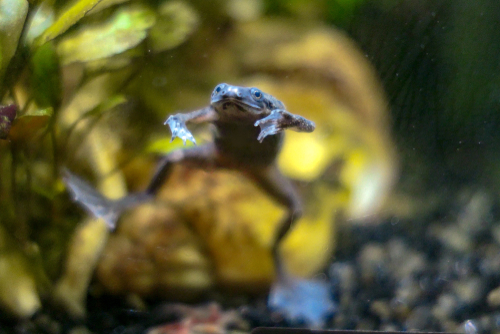
- Scientific Name: Hymenochirus curtipes
- Adult Size: 2-3 inches
- Compatible with: Male and female bettas
- Water Temperature: 68-78°F
- Minimum tank size: Five-gallon
- Care Level: Easy
- Origin: Africa
These frogs are bottom dwellers, so your betta won’t encounter them too often. They’re active and fun in any tank, and you can fit one to two in a five-gallon aquarium.
The African dwarf frog is nocturnal, so it won’t swim around when your betta is active. Overall, dwarf frogs are very peaceful and won’t fight with your betta fish.
Pros of Keeping Dwarf Frogs With Bettas
- African dwarf frogs don’t leave the bottom of the tank often.
- These frogs have a non-aggressive personality.
- Frogs and bettas are awake at different times.
Cons of Keeping Dwarf Frogs With Bettas
- Betta fish will eat any eggs the frogs lay.
- The frogs will get aggressive if they don’t get enough to eat.
Outro
So, if you were searching for “15 best betta tank mates 5 gallons” on Google, you now know what fish can get along with your betta. Cory Cats and Rasboras are some of the best fish species. Plus, you can pick between a variety of snails and shrimp.
No matter what, you need to ensure the fish you add to the betta tank is relaxed and non-territorial. If they fight with your betta often, you’ll need to remove them. Overall, you’ll have plenty of options to build a stunning community tank where your betta fish can take center stage!
Frequently Asked Questions
What Fish Can I Put in a 5 Gallon Tank With a Betta?
Any peaceful fish can go in a tank with a betta. Some of the best species include Rasboras and Cory Cats because they’re shy and relaxed. They won’t pick fights with the betta and will do their best to avoid them.
How Many Betta Fish Can I Put in a 5 Gallon Tank?
There should be only one betta fish in a five-gallon tank. They’re highly territorial, and a five-gallon will only have enough space for one, which would cause stress and other issues with overcrowding.
Can a Betta Have Tank Mates in a 5 Gallon?
You can have a betta and tank mates in a five-gallon aquarium, but you must choose small tank mates. Many fish keepers prefer bottom feeders, shrimp, and snails because they won’t overcrowd the betta.
Always introduce the tank mate carefully and have another tank ready if you need to remove the fish.

Ian Sterling, founder of Fishlab.com, began his aquarium journey over 30 years ago, driven by a deep fascination for fish and their diverse personalities. His website, Fishlab.com, is dedicated to making fishkeeping accessible and enjoyable, offering beginner-friendly guidance, expert insights, and a community for aquarists to connect and share experiences.


